
Carpenter bees are species in the genus Xylocopa of the subfamily Xylocopinae. The genus includes some 500 bees in 31 subgenera. The common name "carpenter bee" derives from their nesting behavior; nearly all species burrow into hard plant material such as dead wood or bamboo. The main exceptions are species in the subgenus Proxylocopa, which dig nesting tunnels in suitable soil.

The genus Halictus is a large assemblage of bee species in the family Halictidae. The genus is divided into 15 subgenera, some of dubious monophyly, containing over 200 species, primarily in the Northern Hemisphere. Most species are black or dark brown, sometimes metallic greenish-tinted, with apical whitish abdominal bands on the terga.

Distichodus is a genus of freshwater fish in the family Distichodontidae found in Africa.
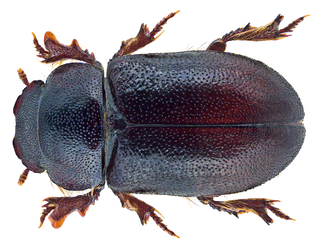
Cheirodes is a genus of darkling beetles in the Melanimonini tribe. It was formerly known as Anemia until 1973, when T. J. Spilman determined Anemia to be a synonym of CheirodesGéné, 1839.

In biology, Lipotriches is a large genus of sweat bees in the family Halictidae, distributed widely throughout the Eastern Hemisphere though absent from Europe. There are nearly 200 species in 9 subgenera. They commonly have prominent bands of hair on the margins of the metasomal segments.

Rhynchium is an Australian, Afrotropical, Indomalayan and Palearctic genus of potter wasps.
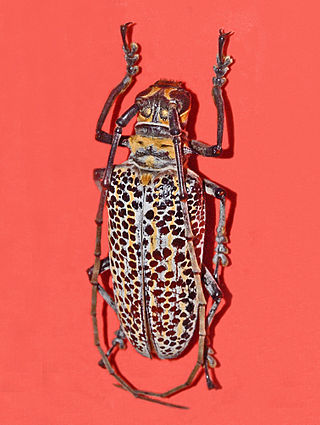
Rosenbergia is a genus of longhorn beetles in the subfamily Lamiinae, close to the genus Batocera.

Cyclommatus is a genus of the family Lucanidae, also known as the stag beetle. The majority of the species from the genus Cyclommatus are located in Southeast Asia, though some species are found in China and Taiwan as well. The genus Cyclommatus also consists of three subgenera: Cyclommatus, Cyclommatinus and Cyclommatellus. Each subgenera contains 80, 24 and 3 species respectively. In total, the genus Cyclommatus consists of a total of 134 species, though more are still being discovered to this day.
Coenraad Ritsema, also Cornelius Conrad Ritsema was a Dutch entomologist.
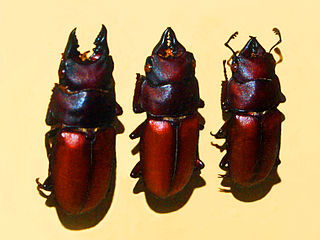
Prosopocoilus is a genus of beetles of the family Lucanidae.
Diplophos is a genus of bristlemouths.

The beaver beetle is an ectoparasitic beetle that is only found on its host species, beavers, and the sole member of the genus Platypsyllus. It is flattened and eyeless, resembling a flea or tick. It used to be placed in a separate family called Leptinidae, but is now placed in the family Leiodidae, in the subfamily Platypsyllinae.
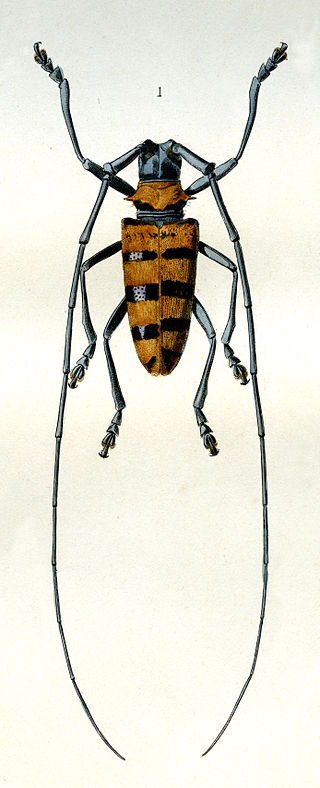
Nemophas is a genus of longhorn beetles of the subfamily Lamiinae, containing the following species:
Steganomus nodicornis is a species of bee in the genus Steganomus, of the family Halictidae.
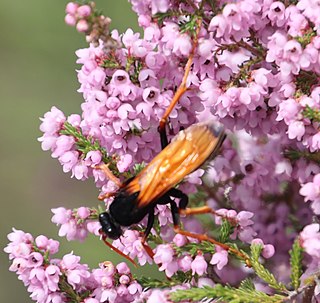
Hemipepsis is a genus of large pepsine spider wasps found throughout the tropics. They are commonly known as tarantula hawks. Hemipepsis wasps are morphologically similar to the related genera Pepsis and Entypus, but distinguishable by the pattern of wing venation. In South Africa 18 plant species from three plant families, the Apocynaceae, Orchidaceae, and Asparagaceae subfamily Scilloideae are pollinated exclusively by Hemipepsis wasps.

Sphecodes is a genus of cuckoo bees from the family Halictidae, the majority of which are black and red in colour and are colloquially known as blood bees. Sphecodes bees are kleptoparasitic on other bees, especially bees in the genera Lasioglossum, Halictus and Andrena. The adults consume nectar, but because they use other bees' provisions to feed their offspring they do not collect pollen.

Nomiinae is a subfamily of sweat bees in the family Halictidae. There are about 11 genera and at least 550 described species in Nomiinae.

Anthidiellum is a genus of rotund resin bees in the family Megachilidae. There are more than 60 described species in Anthidiellum.
Euaspis is a genus of cuckoo bees belonging to the family Megachilidae.
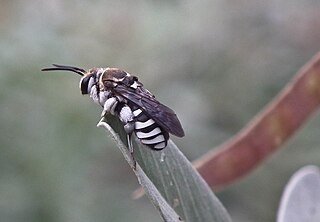
Pseudapis is a genus of bees belonging to the family Halictidae.















